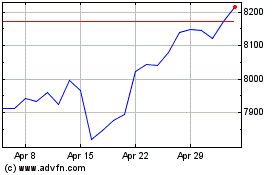S&P 500, Nasdaq End Week at Records
November 27 2020 - 1:35PM
Dow Jones News
By Anna Hirtenstein
U.S. stocks edged higher during Friday's holiday-shortened
session as gains across shares of technology and health-care
companies pushed the S&P 500 and the Nasdaq Composite to new
closing records.
The broad S&P 500 added 0.2% as of the early 1 p.m. ET close
of trading in New York, while the Nasdaq advanced 0.9%, putting
both benchmarks above closing highs set earlier this week. The Dow
Jones Industrial Average also traded higher, gaining 38 points to
29910, but fell short of hitting a new milestone.
Markets have been largely buoyant this week, with the Dow
crossing the 30000 mark for the first time Tuesday, even as rising
coronavirus infection levels across the U.S. and economic data
point to a halting recovery that may curb consumer confidence.
Investors appear to be looking ahead to next year, betting that
Covid-19 vaccines will curb the pandemic and allow social and
business activity to return to normal, along with a rebound in
corporate earnings.
"The hopefuls are leading the realists: they believe that the
economy will return to an equilibrium with a high growth rate. They
are looking beyond the shock," said Sebastien Galy, a macro
strategist at Nordea Asset Management. "It's a matter of time
though: there are still deep underlying issues with Covid spiking
in the U.S."
Investors' zeal for stocks amid all of that has pushed the three
major benchmarks up more than 2% this week, while gains for
November have extended into double-digit percentages. The Dow has
added nearly 13% since the end of October, on track to notch its
biggest monthly advance since 1987. The S&P 500 and Nasdaq
Composite have risen 11% and 12%, respectively, their biggest
month-to-date gains since April.
Still, analysts and investors warn that stocks appear to be
putting themselves on a high ledge as the coronavirus pandemic
worsens. The number of people hospitalized in the U.S. due to
Covid-19 surpassed 90,000 for the first time. More than 110,000 new
cases were reported around the nation Thursday, sharply lower than
totals in recent days. But infection levels are likely to rise
again because of large gatherings and reunions for the Thanksgiving
Day celebrations.
"There's still a lot of cases and restrictions in the U.S.: a
lot of activity is going to stall again," said Samy Chaar, chief
economist at Lombard Odier. "This will have an impact potentially
on the next job market report," he said, referring to labor-market
figures for November that will be released Dec. 4.
One concern that appears to be simmering down is the outcome of
the election. President Trump said Thursday that he would leave the
White House if the electoral college backs Joe Biden. The
president's campaign has lost several legal challenges that allege
election fraud, and he has come under pressure from Republicans to
accept the results.
"He lost big enough for this election to be very difficult to
contest. It's a done deal for markets," said Mr. Chaar. "Everyone
is working under the assumption that it will be a Biden
administration."
Meanwhile, Black Friday kicks off the traditional start of the
crucial holiday shopping season in the U.S. Investors will be
closely watching metrics such as e-commerce and mobility data to
try to gauge consumer confidence and the extent that the pandemic
and historically-high levels of unemployment will weigh on the
retail sector.
"Given the difficult year for so many retailers, there's
definitely going to be expectations for them to try to play catch
up," said Esty Dwek, head of global market strategy at Natixis
Investment Solutions. Black Friday "should give a nice bump to the
[economic data] numbers."
Overseas, the pan-continental Stoxx Europe 600 wavered between
small gains and losses. The U.K. was the worst-performing stock
market in Europe Friday, with the benchmark FTSE 100 index sliding
0.5%.
In Asia, most major stock benchmarks gained. The Shanghai
Composite Index climbed 1.1%, and Hong Kong's Hang Seng Index added
0.3%. Profits at China's industrial firms in October rose over 28%
from a year earlier, an acceleration from the 10% rise the previous
month, in yet another sign of the strength of the country's
recovery.
-- Michael Wursthorn contributed to this article.
Write to Anna Hirtenstein at anna.hirtenstein@wsj.com
(END) Dow Jones Newswires
November 27, 2020 13:20 ET (18:20 GMT)
Copyright (c) 2020 Dow Jones & Company, Inc.
FTSE 100
Index Chart
From Mar 2024 to Apr 2024

FTSE 100
Index Chart
From Apr 2023 to Apr 2024
